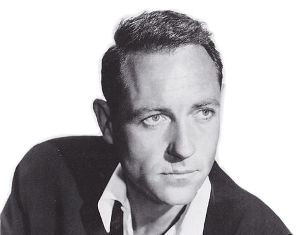A couple months ago my son Tim asked me, “How many ‘Tim Walters’ are there in the world?” Good question, probably a lot. And then I thought, hmm, I bet there’s a website for this question … and, of course, there is: HowManyOfMe.com. According to this website, which uses statistics from the Census Bureau, there are 403 people in the U.S. named “Timothy Walters.” The website offers suggestions of “Famous people with the last name ‘Walters.’” The first name it listed was “Charles Walters.” We all know Barbara Walters, but I had no idea who is Charles Walters, so I looked him up in Wikipedia. It turns out the famous Charles Walters was born in Pasadena, California, as both my father and I were. He was also born with the last name of “Walter,” as was my father’s paternal grandfather. Two strange coincidences.
I wanted to learn more about Charles Walters, so I read his biography by former Joffrey Ballet soloist, Brent Phillips, Charles Walters: The Director Who Made Hollywood Dance. Chuck was one of the most prolific directors during the Golden Age of Hollywood musicals. He started out as a naturally-gifted dancer, made it on Broadway as a dancer, quickly became a choreographer on stage and then for film, and just as quickly became a film director under a long-time contract with MGM. One of his closest friends was Judy Garland, whom he directed several times. Recall a big name from that era and he directed them in musicals and comedies: Grace Kelly, Frank Sinatra, Esther Williams, Fred Astaire, Ginger Rogers, Gene Kelly, Doris Day, Bing Crosby, and on and on.
Many people who knew Chuck personally called him the most underrated director in Hollywood and the most humble and talented person they ever knew. He would direct and choreograph people not by telling them what to do but by physically performing their parts by acting, singing, and dancing, often better than they could themselves. Sometimes he would do multiple parts at the same time.
The name of “Charles Walters” as a legendary dancer, choreographer, and film director is virtually unknown in 2017 beyond the world of film buffs, yet his legacy is immense. I had a fascinating time reading this book. Though Chuck’s life wasn’t overly dramatic, filled with tales of self-destruction, such as with his friend Judy Garland, this book really impacted me by reading the name “Walters” over and over, many hundreds of times. The book made me think about more than leaving a legacy, which is central to my occupation, it made me ask myself, “How am I living a legacy.”
Walters was born November 17, 1911, and died August 13, 1982, from mesothelioma, a devastating cancer most commonly associated with prolonged exposure to asbestos. Chuck’s symptoms emerged full-force at the same time as HIV/AIDS was erupting within the gay community in California. Some people think Walters died from AIDS because he was gay. No, his mesothelioma was caused by the asbestos-laden studios at MGM where he worked for decades. His relatively moderate smoking and drinking didn’t help either.
Charles Walters in his just-shy-of-71-years of earthly life just wanted to entertain people. When movies moved on from musicals and contrived comedies to the “serious” films of the 1970s like Kubrick’s 1971 A Clockwork Orange, Walters knew his time in Hollywood was over. Long before marriage to someone of the same gender was ruled a constitutional right, Walters and his partner, many years his junior, opted for their only legal option to prevent massive government taxation of Walters’s estate. Walters adopted his partner as his son.
There are several questions inspired by the life of Charles Walters that we United Methodist Christians should be asking ourselves:
- How do we live out our legacy of John Wesley’s dying words, “The best of all is, God is with us,” when the world seems consumed with the nihilism evident in A Clockwork Orange?
- How do we live our legacy within a system predicated on doing things the way they’ve always been done, even though decline abounds? (MGM dominated movies through the late 1950s but declined precipitously in the 1960s when it didn’t pivot to the cultural changes.)
- How do we humbly live our legacy by proclaiming “that all persons are of sacred worth,” as found in the Discipline, yet the same Discipline discriminates against entire classes of people by ruling their very lives as “incompatible with Christian teaching” and ineligible for our sacred institutions of marriage and ordination?
How we live our lives in the here and now is just as much our lasting legacy as is the plan we make for our financial assets to do good in the world beyond our earthly lives.



